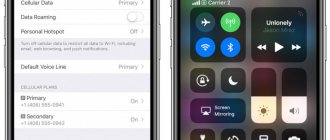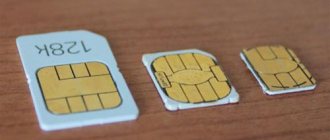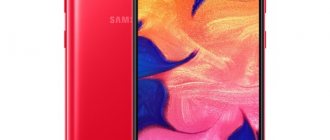eSim, a technology that is successfully used in most countries of the world, has met with stiff resistance from the authorities in Russia. The fact is that the use of eSim goes against Russian laws, and there are only two ways out of this situation - either refuse to use electronic SIM cards in principle, or change the legislation. Since even Russian bureaucrats cannot stop the flywheel of progress, the second path was chosen - legalizing eSim at the legislative level. The Ministry of Telecom and Mass Communications is already preparing amendments, but this procedure is apparently far from being completed. For now, Russian subscribers can use eSim only in test mode.
What is eSim?
eSim is a full-fledged virtual alternative to that piece of plastic that we have to constantly look for a needle to remove from our smartphone. Essentially, this is a chip that takes up very little space in the smartphone body. In terms of functionality, eSim is 100% similar to a physical SIM card - you can also make calls, send messages, use the mobile Internet and distribute it.
Which Apple gadgets support eSIM
Among iPhones, eSIM is supported by the following models:
► iPhone Xs and Xs Max ► iPhone XR ► iPhone SE 2nd generation ► iPhone 11 ► iPhone 11 Pro and Pro Max ► iPhone 12, 12 mini, 12 Pro and Pro Max
Any iPhone with two physical SIM cards (such as those sold in China) is not suitable for eSIM. eSIM for Apple Watch is not fully supported by Russian operators.
And among tablets, any one will suit you, starting from the cheapest iPad 7th generation and newer. Just note that the iPad itself must be one of the models with a physical SIM card, that is, with a SIM slot. Without it, you won't be able to add an eSIM.
The full list of supported models, including Android smartphones, can be found on the operator’s website.
Benefits of eSim
The main advantage is that the user can change the operator remotely - that is, without visiting a service office. If I wanted, I called from MTS, if I wanted, I switched to Tele2 and bought gigabytes of Internet on the famous exchange for next to nothing. And it is not at all necessary to have a dual-SIM smartphone - especially since there are few of these among the top models. However, for modern Russian realities this is an advantage only in theory. Looking ahead, we note that now only one operator has the right to distribute eSim - so there is nowhere to switch.
eSim is indispensable within the framework of the Internet of Things concept, which is becoming a new global trend. SIM cards are used not only for phones, but also for smart watches, GPS trackers - even suitcases, as we learned from a popular advertisement with Nagiyev. One eSim could be used in all elements of a smart home at once.
Can I connect Truphone or GigSky right now?
If you agree with their prices, then yes. If you bought one of the new iPhones or have an Apple Watch with eSIM support, you can check out the new product for yourself. But keep in mind that your card will immediately be charged the cost of the tariff for the specified period.
Activating an eSIM is quite simple. You need to download the Truphone or GigSky application, select your region, select a tariff plan and pay for it.
The fact that we can connect eSIM from foreign operators is not bad. For example, on vacation you can get a local SIM card right at the hotel, without being distracted from your tourist route. In addition, in comparison with the roaming prices of our operators, GigSky and Truphone are much more profitable. But within Russia, of course, these operators will not be particularly popular; our local tariffs are cheaper.
Which phones support eSim?
There are still few smartphones that support eSim, and all of them belong to the premium segment:
- Apple iPhone – XR, XS, XS Max and 11 models.
- Google Pixel 3 and 4 generations.
- LG G7 ThinQ.
Tablets also support eSim:
- iPad Pro 11 inches.
- iPad Pro 3 version 12.9 inches.
- iPad Air 3.
- iPad Mini 5.
- Microsoft Surface 5th and 6th generations.
There are several smartwatch models that support an electronic SIM card. We are talking about Apple Watch 3 and 4, Samsung Galaxy Gear S3 and Huawei Watch 2.
Why don't Russian operators support eSIM?
This is illegal here. Smartphones come pre-installed with a programmable SIM card module. This way you can change operators on the fly: without having to throw away plastic.
Nowadays, a SIM card is assigned to a specific user under a contract with an operator. Due to the nature of eSIM, the user may violate the terms of the contract by changing the operator without warning. In addition, according to the law, eSIM can be equated to “illegal access to computer information protected by law,” and this is already a criminal offense: Articles 272 and 273.
Which operators support eSim in Russia?
Beeline, Megafon and MTS immediately accepted the eSim technology with hostility, since it poses a danger to their commercial positions. Firstly, this will boost sales of Apple gadgets, from which operator retail networks traditionally have the smallest margins. Secondly, new competitors will appear in the form of virtual operators who, according to rumors, are ready to offer subscribers more favorable conditions. So the “big three” do not yet connect eSim.
But the Tele2 company embraced the innovation with enthusiasm, seeing a promising opportunity to lure users over. In April 2022, this operator began connecting eSim to subscribers in test mode. In May, a few weeks later, Tele2 had to shut down the project at the request of the Ministry of Telecom and Mass Communications, which doubted the information security of the technology. Since September 2022, Tele2 has received permission from the authorities to resume distribution of eSim - on a testing basis. The operator still distributes electronic SIM cards.
Since October 2022, the virtual operator Easy4, which operates on Tele2 networks, has also received permission to distribute eSim. However, the services of this company are focused only on tourists and the Internet of Things. Easy4 is not a competitor to the Big Three.
In March 2022, eSim began to be distributed. Tinkoff, like Easy4, uses Tele2 networks and is not a provider - but it offers an advantage that the operator itself cannot boast of (more on this later). There is information that VTB Mobile is also considering the possibility of introducing electronic SIM cards.
Impressions of MTS eSIM at work
Everything is predictably normal. eSIM from MTS, MegaFon or Beeline are no different from a physical SIM card. The same tariffs, services, the same connection and signal reception level.
If anything, you cannot use one number via eSIM and a physical card at the same time. The one activated later will be blocked automatically.
MTS claims that the issued QR code for a virtual SIM card can be used up to 100 times, and it does not “burn out.” But with one condition: before scanning the code again, you must remove the eSIM from your previous device. On iOS, this is done in Settings -> Cellular data -> Cellular tariffs -> your MTS eSIM -> Delete cellular tariff.
Remember the procedure and do not lose the QR code, because the eSIM will have to be set up again when you change your smartphone or restore its backup. Otherwise, it will be possible to restore the eSIM, as well as the number associated with it, only in the operator’s salon.
How to connect eSim in Russia?
The procedure for connecting eSim to Tele2 is as follows:
- You come to the Tele2 sales office with a passport and a smartphone that supports eSim. Ask the employee for a QR code to switch to an electronic SIM card.
- On your smartphone, follow the path “Settings” - “Cellular” - “Add cellular tariff”.
- Take a photo of the QR code issued at the office.
- Choose whether the added card should be considered the main or additional one.
- Reboot your smartphone. Before the reboot, both cards may become unavailable - this is a completely normal story.
Tinkoff Mobile, unlike Tele2, makes it possible to connect to eSim without visiting the office - just scan a QR code, for example, from a roadside billboard. However, only Tinkoff card holders will be able to use it.
eSIM is also connected in MTS stores
You can also connect MTS eSIM in MTS stores. You can find the nearest address here.
Take your passport with you and, preferably, the device on which you plan to activate the SIM card. Give the document to the consultant, select a tariff, pay and receive your virtual eSIM in the form of a QR code on the receipt.
The code must be photographed through the Settings -> Cellular -> Add cellular tariff menu. Do not throw away the receipt, keep it in a safe place.
You can transfer your existing number to eSIM either within MTS or from another operator. In the latter case, you will have to wait up to 14 days as part of the standard number porting procedure. And yes, this can only be done offline, in the salon.
Replacing a physical SIM card with an eSIM version in the salon will be done free of charge. Just to do this, contact a salon in the region of SIM registration, otherwise they will refuse.
Why is eSim contrary to Russian laws?
Any SIM card in Russia, according to the law, must be registered with a citizen’s passport. The state needs to know who owns a particular number. Of course, this rule is not followed in 100% of cases - for example, at many Moscow metro stations you can meet people of dubious appearance who literally “shove” dummy SIM cards to passers-by, that is, without money. However, if the authorities turn a blind eye to such “minor pranks,” they could not ignore the emergence of a technology capable of changing the mobile services market.
The issuance of an eSim by Tele2 now requires a mandatory visit to the service office with a passport. Thus, the main convenience of using eSim is eliminated. Tinkoff does not force people to go to its offices, since it already has passport data - the bank receives it when issuing cards. However, applying for a bank card solely to gain access to an eSim is absurd.
Unfortunately, it will not be otherwise - at least until the government figures out how to authenticate a subscriber remotely and makes amendments to the legislation.
The media write that in Russia you can connect eSIM. This is true?
Yes this is true. The only problem is that Russian operators do not work with eSIM. So far, Truphone and GigSky are servicing built-in SIM cards in Russia.
These operators have long begun to provide their services in Russia. Including eSIM. Truphone started working with us back in 2007 as a dialer application for phones like the Nokia N95. And GigSky began selling eSIM to Russians in 2015. Therefore, there is no sensation here.
If you decide to connect eSIM GigSky or Truphone, then remember: these are global operators, and their prices are in pounds, euros and dollars. Here, for example, is the cost of Truphone tariff plans:
523 rubles for 300 MB per day, 1307 rubles for 1 GB per month, 3662 rubles for 3 GB per month
The picture is approximately the same for GigSky:
| Internet | Duration | Price |
| 300 MB | 1 day | 676 rubles |
| 500 MB | 15 days | 1015 rubles |
| 1 GB | 15 days | 1353 rubles |
| 2 GB | 15 days | 2030 rubles |
| 5 GB | 30 days | 3383 rubles |
Comparison with our tariffs, I think, is unnecessary.
What's next?
Biometrics will certainly be the solution. Now everything depends on Rostelecom, which is tasked with developing a unified biometric system (UBS) in Russia. 172 Russian banks have already been connected to the EBS, next in line are government service websites, and only then mobile operators. According to the top manager of Rostelecom, it will be possible to register with the operator by saying a phrase into the microphone or taking a photo with the front camera of the computer.
However, the issue here is not only purely technical, but also bureaucratic. The Ministry of Telecom and Mass Communications was supposed to prepare, together with the FAS and FSB, a regulatory framework for the legalization of eSim. Deputy Head of the Ministry of Telecom and Mass Communications Oleg Ivanov promised that the documents would be ready by January 15, 2020, but later he himself proposed postponing the preparation of the standards until the end of 2022. So, alas, even if Rostelecom hurries up, we will hardly be able to take advantage of all the benefits of eSim until 2022.
Operators fear loss of traffic
The first reason for the lack of eSIM in Russia is fears on the part of operators. “On the one hand, there is a risk of withdrawal and loss of subscriber traffic, on the other hand, this makes it possible to build a new business model, since the consumer will use an electronic SIM card longer than a regular one,” explained TJ, executive vice president for corporate strategy and Beeline business development Alexander Popovsky.
Due to the lack of a large number of new subscribers, companies are fighting for customer loyalty and used traffic, Denis Kuskov, CEO of the analytical agency TelecomDaily, explained to TJ. “In this case, they are probably afraid that part of the money will go not to them, but to third-party operators,” he suggested.
The law considers eSIM to be SIM card cloning
The second reason why Russian operators are considering, but do not yet support eSIM, is a legal ban. As confirmed by the press service of MegaFon, which tested the technology back in 2016, the Law “On Communications” still equates eSIM to cloning a SIM card. If the SIM card is a unique subscriber identifier, then eSIM identification excludes.
“eSIM suggests the ability to switch between operator networks without visiting the operator’s office, but in Russia the SIM card number is fixed in the subscriber agreement,” said Popovsky from Beeline. According to him, operators have not yet determined what specific scenarios for using eSIM in Russia may arise, for example, connecting and disconnecting subscribers. We are constantly monitoring the development of the situation, subscribe to our telegram channel, which always contains the latest information about eSiM technology.
eSIM in Russia: favorable tariffs for mobile Internet
There is a popular joke about eSIM: Do you see a gopher? And he is! It’s the same here: the smartphone receives calls, sends messages, picks up an Internet signal, but it doesn’t have a SIM card in the usual sense. There is a built-in chip that supports all this functionality. It cannot be removed or moved to another device, but you can connect a SIM card or tariff by simply scanning the QR code.
There are many advantages of an electronic SIM card:
- eSIM is more reliable and does not cause mechanical failures,
- These chips are smaller in size and fit comfortably into the latest generation of Apple smartphones and smartwatches.
- They are convenient to use for international travel - you can combine the services of several operators in one smartphone and no longer have to rearrange SIM cards. The leapfrog with various gadgets for the Internet and communications is also cancelled,
- Savings on communication services, including international roaming - the subscriber, as soon as he gets off the plane in another country, receives offers from local tour operators and can connect to a more favorable tariff without visiting telecom stores.
- If the phone is stolen or lost, the SIM card cannot be removed - this increases the chance of tracking the gadget and returning it to the owner. After the theft, the gadget cannot be used for your own benefit - only the real owner can delete the old profile and upload a new one,
- A separate card slot is not needed - the gadget has more memory space.
But, like many new technological features, there are also disadvantages. eSIM allows you to change the operator in a couple of clicks, which the Russian Ministry of Telecom and Mass Communications does not like at all. Officials do not want to give up the scheme, which is convenient for them and cumbersome for subscribers, with visits to communication shops and the provision of passport data to change operators. By law, a SIM card is a unique subscriber identifier and cannot be duplicated. However, providers are not going to miss this opportunity and are exploring ways to implement virtual technologies.
In Russia, eSIM can only be purchased from Tele2; VimpelCom and Megafon are considering implementation options. This technology will gain its greatest scope when the ambitions of the Big Three providers are not restrained by the state and the law. International communications are increasingly relevant in the modern world with its open borders, and this is where eSIM, with its freedom to choose an operator and the speed of switching between tariffs and services, will come in handy.











